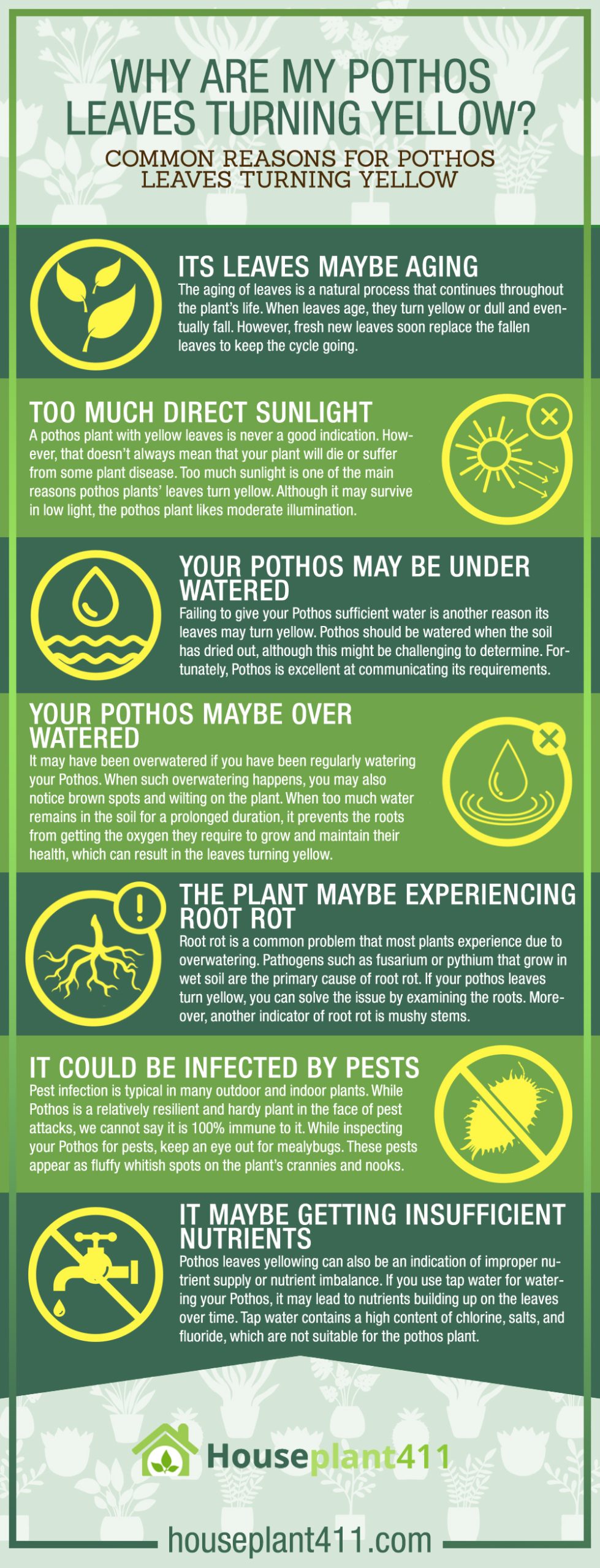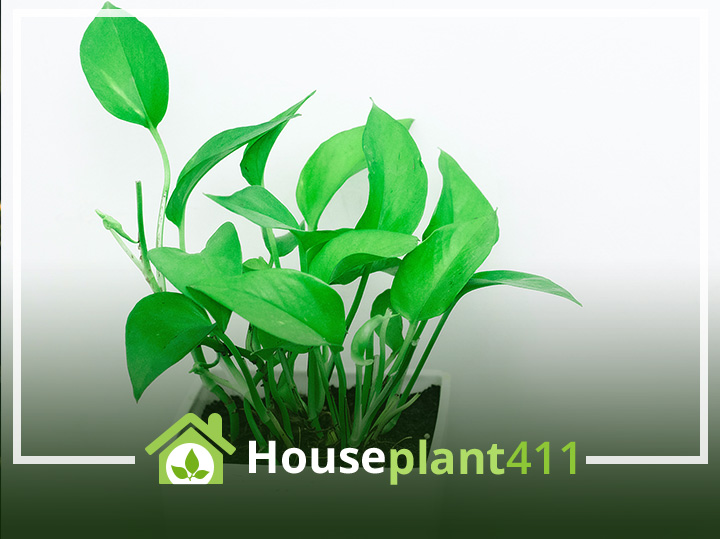Why Are My Pothos Leaves Turning Yellow?
Pathos makes the perfect addition to anyone’s garden or home. These vibrant green plants survive with all plant parents, whether you are a new or experienced plant parent. Their heart-shaped leaves on long stems set them apart from other pants. Therefore, these wonderful plants tend to be at the top of the list of all indoor plant enthusiasts.
Pothos are typically resilient and immune to common plant issues due to low maintenance requirements and hardy nature. While Pothos are extremely forgiving houseplants, they require some care. These plants may start showing signs of stress if they are not provided with the right growing conditions (which are relatively easy to create)
One of the most common ways Pothos express their dissatisfaction or frustration is through leaves yellowing. If you are experiencing the same issue with your plant, you need not worry because we are here to help.
This blog post will cover reasons why your pothos leaves are yellowing. In addition, it will also provide you with a detailed guide on how to reverse the damage caused by these potential problems. So, keep reading to find out!
Common Reasons for Pothos Leaves Turning Yellow
Inspect your pothos plant for the following reasons to determine why its leaves are yellowing:
Its Leaves Maybe Aging
The aging of leaves is a natural process that continues throughout the plant’s life. When leaves age, they turn yellow or dull and eventually fall. However, fresh new leaves soon replace the fallen leaves to keep the cycle going.
If your Pothos is still producing new foliage, appears healthy, and only a couple of leaves are yellowing at a time, you may witness the normal aging process that all plants go through. You don’t have to do much if you believe the leaves are yellowing because they are reaching the end of their natural life. All you need to do is increase the soil’s nutritional content by applying a diluted plant fertilizer. Also, keep a watch on your pothos plant to ensure the leaves aren’t turning yellow due to some other issue.
Too Much Direct Sunlight
A pothos plant with yellow leaves is never a good indication. However, that doesn’t always mean that your plant will die or suffer from some plant disease. Too much sunlight is one of the main reasons pothos plants’ leaves turn yellow. Although it may survive in low light, the pothos plant likes moderate illumination.
However, it cannot stand exposure to direct sunshine. Yellow leaves on your pothos plant may indicate that it has been overexposed to the sun. If you have placed your Pothos in a south-facing window, place it somewhere else or far from direct sunlight. Another solution to the yellow leaves on the pothos issue is to hang a sheer curtain on the window. Doing so would allow your plant to receive filtered light and prevent its leaves from turning yellow. In addition, preventing overexposure to sunlight will also keep the leaves from getting sunburnt.
However, keep in mind that some of the pothos plants’ green leaves may also turn yellow when they don’t receive enough light. It might be challenging to diagnose a lighting problem since plants receiving too much light may also develop a yellow hue. As a basic rule of thumb, remember that Pothos leaves that receive enough sunlight may begin to droop somewhat and appear a touch crispy, while those that receive little sunlight appear plump.
Your Pothos May Be Under Watered.
Failing to give your Pothos sufficient water is another reason its leaves may turn yellow. Pothos should be watered when the soil has dried out, although this might be challenging to determine. Fortunately, Pothos is excellent at communicating its requirements. When your Pothos lacks water, its leaves and vines start to appear limp and drooping. However, don’t worry. You can fix this by watering it sufficiently. Your Pothos will become vibrant and lively shortly after you have watered it.
If the leaves of your pothos plant appear yellow and crisp, this is another indication that it is not receiving sufficient water. To solve this issue, you must aerate the soil. You can do it by gently tapping the dirt with anything pointed such as a wooden chopstick. Next, water the soil till observed water is dripping from the drainage hole in the pot.
Moreover, always keep an eye out for soil drying out and drooping vines to prevent the leaves from yellowing. However, if there is a watering problem with Pothos, overwatering or uneven watering is much more likely to be the cause than underwatering. So let’s discuss this issue!
Your Pothos Maybe Over Watered
It may have been overwatered if you have been regularly watering your Pothos. When such overwatering happens, you may also notice brown spots and wilting on the plant. When too much water remains in the soil for a prolonged duration, it prevents the roots from getting the oxygen they require to grow and maintain their health, which can result in the leaves turning yellow. However, you can prevent further harm if you think overwatering is the cause of the leaf’s yellowing. Start by trimming the yellow leaves first. Even if the overwatering issue is resolved, these leaves won’t revert to green or healthy.
If you are overwatering your plant, you will notice it immediately because the leaves will soon appear yellow. Like when the Pothos is not receiving sufficient sunlight, the leaves appear plump and crisp. If you notice the water overflowing each time you water it, know that it’s another indication that you have been overwatering your plant.
To solve this issue, you must first ensure that your plant has sufficient drainage holes. This hole will allow excess water to flow by providing a place to escape. Doing so will prevent the soil and roots of your plant from drowning. Your plant will be more prone to damage and root rot if its pot does not have sufficient drainage holes.
You must reduce the watering sessions if your plant is in the right pot with proper drainage holes but is still displaying indications of overwatering. When the soil’s top few inches feel entirely dry, you must water your Pothos only then. You can use a soil moisture-checking meter to check if the soil needs more water. You can also resolve the issue by moving the plant closer to a window. (Keep in mind that greater sunshine means more energy required to process water.)
If the soil takes too long to dry, you can solve this by moving the Pothos to a sunnier spot. If your plant receives more light, it will use up the moisture faster, preventing the roots from spending extended periods in damp soil.
The Plant Maybe Experiencing Root Rot
Root rot is a common problem that most plants experience due to overwatering. Pathogens such as fusarium or pythium that grow in wet soil are the primary cause of root rot. If your pothos leaves turn yellow, you can solve the issue by examining the roots. Moreover, another indicator of root rot is mushy stems.
To inspect the plant for root rot, remove it from the pit and observe its root ball. While doing so, ensure you provide sufficient support to the plant’s base. If the roots appear black, brittle, and mushy, you can be sure that the plant is suffering from root rot.
While root rot is irreversible in most cases, you can save your plant if some of the roots look firm or pale. Follow these simple steps to reverse and prevent further damage to your Pothos in case of root rot:
- Start by raising the roots gently in lukewarm water to get rid of as much soil as you can. Next, use pair of sharp shears to remove the roots that have turned black or are rotten. The healthy roots will still feel firm, as opposed to rotten roots, which are mushy and spongy. So, make sure you keep the healthy ones.
- You must also throw away the old potting mix and replace it with a fresh one.
- Wash the pot with a weak bleach solution to remove any leftover bacteria.
- Report the Pothos in new, well-draining potting soil; you might need a smaller pot if you’ve removed a large amount of the roots that were rotten.
- Before replanting, it would be best to soak the roots in a fungicide.
- Next, you must remove any yellow or damaged leaves. To do so, use an antibacterial solution to clean the shears and get rid of any pests or bacteria. It would be best if you also pruned any additional leaves, proportioning them to the number of roots you have removed. The purpose of pruning the additional leaves is to ensure that the leftover roots are adequately supported by supporting a larger plant.
It Could Be Infected By Pests
Pest infection is typical in many outdoor and indoor plants. While Pothos is a relatively resilient and hardy plant in the face of pest attacks, we cannot say it is 100% immune to it. While inspecting your Pothos for pests, keep an eye out for mealybugs. These pests appear as fluffy whitish spots on the plant’s crannies and nooks. However, they are easy to remove. You must dip a cotton pad in an eco-friendly pest solution and run it in the affected areas.
Apart from mealybugs, it would be best if you also kept an eye out for spider mites. These pests are relatively challenging to detect. As the name suggests, they appear similar to tiny spiders. If you notice white webbing on your plant, you’ll know spider mites have infected your plant. Keep the Pothos separate from other plants and spray it with water to get rid of the spider mites. You can also get rid of the pests by using neem oil or insecticidal soap.
It Maybe Getting Insufficient Nutrients
Pothos leaves yellowing can also be an indication of improper nutrient supply or nutrient imbalance. If you use tap water for watering your Pothos, it may lead to nutrients building up on the leaves over time. Tap water contains a high content of chlorine, salts, and fluoride, which are not suitable for the pothos plant. Moreover, the yellowing of pothos leaves may also be an effect of too much or too little fertilizer. A pothos requires a balanced amount of potassium, iron, and phosphorus to remain healthy. If you don’t provide these essential nutrients to the plant, its leave may develop yellow spots.
Your plant’s pattern of yellowing may give away what kind of mineral deficiency it is experiencing. For instance, low magnesium levels may cause the Pothos leaves to fade at the edges yet remain green in the center. Moreover, if your plant’s leaf veins and stems appear green, but the remainder of the leaf has become yellow, this may indicate a lack of zinc, iron, or manganese.
If your plant’s upper leaves are going yellow, it may be because there isn’t enough sulfur in the soil. However, if the leaves near the bottom of your plant are yellowing, it indicates a nitrogen deficit. On the other hand, leaves with excess mineral content typically seem burned with brown and yellow “burns” all over them.

Final Word
While pothos plants are relatively low maintenance, they don’t thrive on neglect. Therefore, you must take care of their watering, sunlight, and nutrient requirements. Yellow leaves indicate that your plant is experiencing stress, and you must alter its care routine. Taking care of a few simple steps can help save your plant.
Happing Planting!

